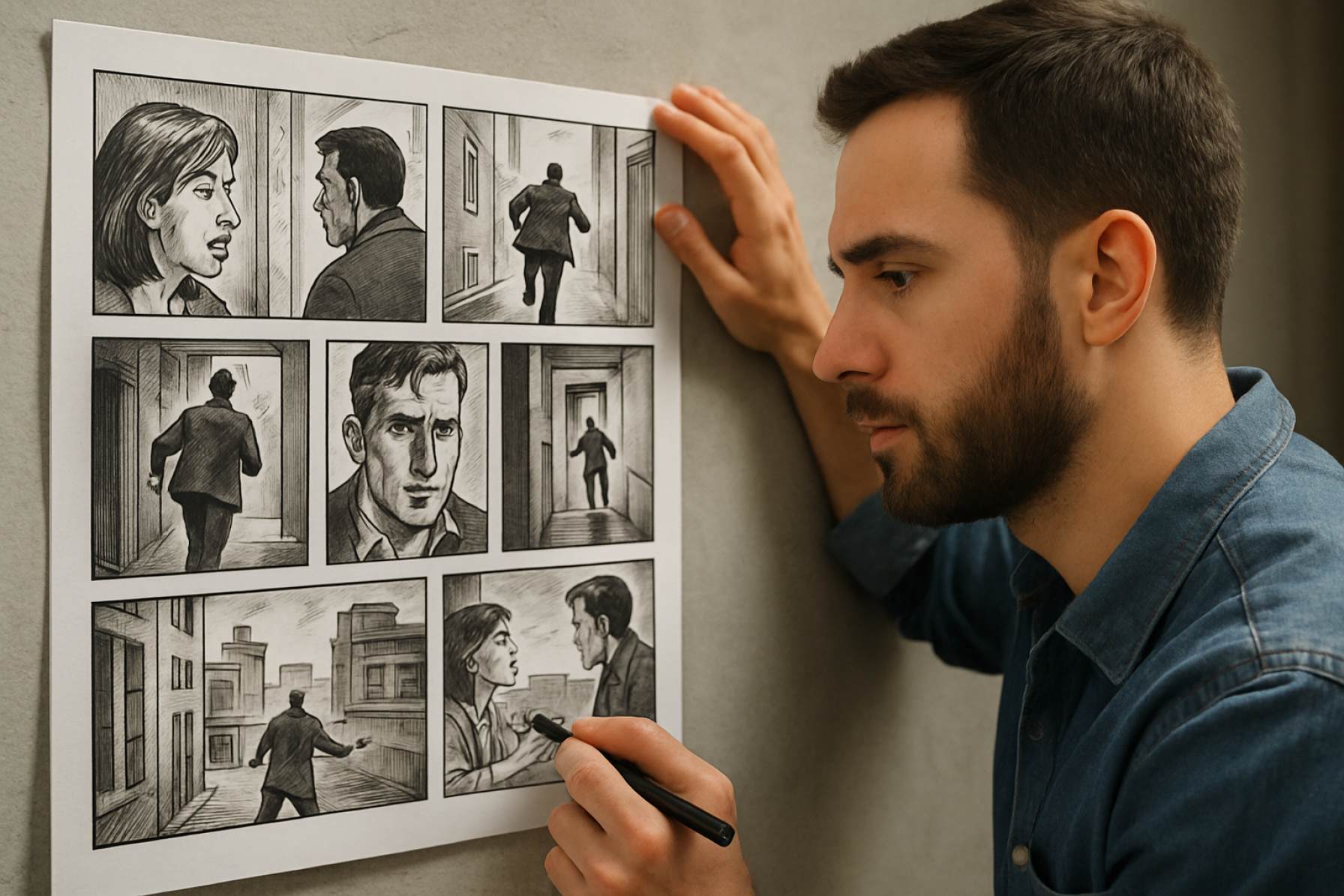Sequence Art: The Dynamic Fusion of Images and Narrative. Discover How Sequential Imagery Transforms Storytelling Across Media.
- Introduction to Sequence Art: Origins and Evolution
- Core Principles: What Defines Sequence Art?
- Techniques and Tools: From Traditional to Digital
- Sequence Art in Comics, Graphic Novels, and Animation
- Visual Storytelling: How Sequence Art Engages Audiences
- Influential Artists and Landmark Works
- The Role of Sequence Art in Modern Media
- Educational and Therapeutic Applications
- Future Trends: Innovations in Sequence Art
- Sources & References
Introduction to Sequence Art: Origins and Evolution
Sequence art refers to the practice of conveying narratives or information through a series of images arranged in a deliberate order. This visual storytelling method has deep historical roots, with early examples found in ancient civilizations. The Bayeux Tapestry, for instance, is a renowned 11th-century artifact that uses embroidered panels to depict the events leading up to the Norman conquest of England, demonstrating the power of sequential imagery long before the advent of modern comics (Bayeux Museum).
The evolution of sequence art accelerated with the invention of the printing press, which enabled mass production of illustrated books and broadsheets. In the 19th century, artists like Rodolphe Töpffer in Switzerland began experimenting with picture stories that combined images and text in panels, laying the groundwork for the modern comic strip (The British Museum). The 20th century saw the rise of comic books and graphic novels, with sequence art becoming a dominant form of popular culture and artistic expression.
Today, sequence art encompasses a wide range of media, from traditional comics and graphic novels to webcomics and digital storytelling platforms. Its evolution reflects broader changes in technology, culture, and visual literacy, making it a dynamic and continually expanding field. The study of sequence art not only reveals the history of visual communication but also highlights its enduring relevance in contemporary society (Library of Congress).
Core Principles: What Defines Sequence Art?
Sequence art is fundamentally defined by its use of multiple images arranged in a deliberate order to convey information, tell a story, or evoke an emotional response. Unlike single-image artworks, sequence art relies on the interplay between images—often accompanied by text—to create meaning through progression and juxtaposition. The core principles that define sequence art include narrative flow, visual continuity, and temporal progression.
Narrative flow refers to the way images are organized to guide the viewer through a story or concept. This can be linear, as in traditional comic strips, or non-linear, as seen in experimental or avant-garde works. Visual continuity ensures that the transition from one image to the next is coherent, using elements like consistent character design, background, and panel layout to maintain clarity. Temporal progression is achieved by depicting changes in time, action, or emotion across the sequence, allowing the viewer to infer movement and causality.
Sequence art is not limited to comics; it encompasses storyboards, graphic novels, picture books, and even some forms of animation and digital media. The medium’s power lies in its ability to compress or expand time, highlight contrasts, and create rhythm through the arrangement of images. These principles have been explored and codified by theorists such as Scott McCloud and institutions like the Cartoon Art Museum, who emphasize the unique communicative potential of sequential imagery.
Techniques and Tools: From Traditional to Digital
Sequence art has evolved significantly in its techniques and tools, transitioning from traditional hand-drawn methods to sophisticated digital processes. Traditionally, artists relied on pencils, inks, and brushes on paper or bristol board, often using lightboxes to trace and refine their work. The process included penciling, inking, and sometimes hand-coloring, with final pages photographed or scanned for reproduction. Tools such as dip pens, technical pens, and India ink were staples, and corrections were made with white-out or by physically cutting and pasting panels (Cartoon Art Museum).
The digital revolution has transformed sequence art production. Artists now use graphic tablets, styluses, and software like Adobe Photoshop, Clip Studio Paint, and Procreate to create, edit, and color their work. Digital tools offer layers, undo functions, and a vast array of brushes and effects, streamlining the workflow and enabling rapid experimentation. Lettering, once done by hand or with adhesive letters, is now typically integrated digitally, allowing for precise placement and easy revisions (Comic-Con International).
Hybrid approaches are also common, with artists combining hand-drawn elements and digital finishing. The shift to digital has democratized sequence art, lowering barriers for independent creators and enabling webcomics and digital-first publications. Despite these advances, many artists still value traditional techniques for their tactile qualities and unique visual textures, leading to a rich diversity of styles in contemporary sequence art (Society of Illustrators).
Sequence Art in Comics, Graphic Novels, and Animation
Sequence art, as a narrative form, finds its most prominent expression in comics, graphic novels, and animation. These mediums utilize a series of images arranged in deliberate order to convey stories, emotions, and ideas, often blending visual and textual elements for a unique storytelling experience. In comics and graphic novels, sequence art is structured through panels, gutters, and page layouts, guiding the reader’s eye and pacing the narrative. The interplay between images and dialogue or narration allows for complex storytelling, as seen in works published by DC Comics and Marvel Entertainment. Graphic novels, in particular, have expanded the scope of sequence art, tackling mature themes and experimental visual styles, as exemplified by titles from Penguin Random House’s graphic novel imprints.
Animation, while distinct in its use of motion, is deeply rooted in the principles of sequence art. Storyboards—sequential drawings that map out scenes—are essential in the animation process, providing a visual script for animators. Studios like Pixar Animation Studios and Studio Ghibli rely on sequence art to plan narrative flow, character movement, and visual composition before full animation begins. The transition from static panels to moving images demonstrates the adaptability of sequence art across media, highlighting its foundational role in visual storytelling. Through these forms, sequence art continues to evolve, shaping how stories are told and experienced in contemporary culture.
Visual Storytelling: How Sequence Art Engages Audiences
Sequence art excels at visual storytelling by arranging images in a deliberate order to convey narrative, emotion, and action. Unlike single illustrations, sequence art—such as comics, graphic novels, and storyboards—relies on the interplay between panels to guide the viewer through a story. This sequential structure allows creators to control pacing, reveal information gradually, and build suspense or humor through timing and juxtaposition. The use of visual cues, such as panel size, shape, and composition, further enhances the storytelling experience, directing the reader’s attention and evoking specific emotional responses.
One of the key strengths of sequence art is its ability to engage audiences on multiple levels. Readers are not passive recipients; they actively interpret the transitions between panels, filling in gaps with their imagination. This participatory aspect fosters a deeper connection to the narrative. Additionally, sequence art can transcend language barriers, making stories accessible to a global audience through universally understood visual symbols and expressions. The combination of text and imagery also allows for nuanced storytelling, where dialogue, narration, and visual elements work together to create meaning.
Contemporary research highlights how sequence art can improve literacy and visual comprehension, especially among young readers and those learning new languages. Its unique blend of art and narrative continues to influence not only entertainment but also education and communication strategies worldwide (Comic-Con International; Graphic Novel Reporter).
Influential Artists and Landmark Works
Sequence art has been shaped by a diverse array of influential artists and landmark works that have defined and expanded the medium’s expressive potential. Among the earliest pioneers is Richard F. Outcault, whose creation of “The Yellow Kid” in the late 19th century is often credited as the first modern comic strip, introducing recurring characters and speech balloons. In the early 20th century, George McManus’s “Bringing Up Father” and Hergé’s “The Adventures of Tintin” set new standards for visual storytelling and narrative clarity.
The mid-20th century saw the rise of American superhero comics, with Bob Kane and Jerry Siegel & Joe Shuster creating enduring icons like Batman and Superman. Meanwhile, Stan Lee and Steve Ditko revolutionized the genre with Spider-Man, emphasizing character-driven narratives.
In the realm of graphic novels, Art Spiegelman’s “Maus” broke new ground by using sequence art to explore historical trauma, earning a Pulitzer Prize and expanding the medium’s literary credibility. Jean Giraud (Moebius) and Katsuhiro Otomo’s “Akira” further demonstrated the global reach and artistic versatility of sequence art.
These artists and their landmark works have not only influenced generations of creators but have also established sequence art as a vital and evolving form of visual storytelling.
The Role of Sequence Art in Modern Media
Sequence art, traditionally associated with comics and graphic novels, has become a foundational element in modern media, shaping how stories are told across diverse platforms. Its core strength lies in its ability to convey narrative through a series of images arranged in a deliberate order, allowing for nuanced pacing, visual symbolism, and emotional resonance. In contemporary contexts, sequence art extends far beyond printed comics, influencing film storyboarding, animation, video games, and even digital marketing campaigns.
In film and television, sequence art is integral to pre-visualization processes. Storyboards—essentially a form of sequence art—help directors and cinematographers plan shots, transitions, and visual effects, ensuring narrative coherence and creative intent before filming begins. This practice is standard in major studios such as Pixar Animation Studios and Marvel Studios, where complex visual storytelling demands meticulous planning.
The rise of webcomics and digital platforms has further democratized sequence art, enabling creators to reach global audiences without traditional publishing barriers. Social media platforms like WEBTOON and Tapas Media have popularized vertical scrolling formats, adapting sequence art to the habits of mobile users and fostering new narrative techniques.
Moreover, sequence art’s influence is evident in video game design, where cutscenes and interactive storyboards guide player experience and immersion. As visual literacy becomes increasingly important in a media-saturated world, sequence art continues to evolve, shaping how stories are constructed, consumed, and understood in the digital age.
Educational and Therapeutic Applications
Sequence art, which encompasses comics, graphic novels, and visual storytelling, has found significant applications in both educational and therapeutic contexts. In education, sequence art is increasingly recognized as a powerful tool for enhancing literacy, visual thinking, and narrative skills. By combining images and text, sequence art supports multimodal learning, making complex concepts more accessible to diverse learners, including those with learning disabilities or language barriers. For example, educators use comics to teach history, science, and social skills, leveraging the format’s ability to break down information into manageable, engaging segments. Research by the Reading Rockets highlights how graphic novels can motivate reluctant readers and foster critical thinking.
Therapeutically, sequence art is utilized in art therapy and mental health interventions. Creating or interpreting comics allows individuals to externalize emotions, process trauma, and develop coping strategies in a non-threatening, creative environment. Art therapists often employ sequence art to help clients narrate personal experiences, facilitating self-expression and emotional regulation. The American Art Therapy Association acknowledges the value of visual storytelling in therapeutic settings, noting its effectiveness with children, adolescents, and adults alike. Additionally, sequence art is used in social skills training for individuals with autism spectrum disorder, helping them understand social cues and sequences of events through visual narratives.
Overall, the integration of sequence art into educational and therapeutic practices demonstrates its versatility and efficacy in supporting cognitive, emotional, and social development across various populations.
Future Trends: Innovations in Sequence Art
The future of sequence art is being shaped by rapid technological advancements and evolving audience expectations. Digital platforms are enabling artists to experiment with interactive and multimedia storytelling, blurring the lines between traditional comics, animation, and video games. Tools such as augmented reality (AR) and virtual reality (VR) are allowing readers to immerse themselves in narrative worlds, offering new dimensions of engagement and interactivity. For example, AR applications can overlay animated panels onto physical comic pages, while VR environments can place viewers directly inside a story’s setting, transforming passive reading into an active experience (Marvel Entertainment).
Artificial intelligence (AI) is also beginning to influence sequence art creation. AI-driven tools can assist with tasks such as panel layout, colorization, and even script generation, streamlining the creative process and opening the field to new voices and experimental formats (Adobe Sensei). Additionally, blockchain technology is being explored for digital ownership and distribution, allowing artists to monetize their work through non-fungible tokens (NFTs) and reach global audiences without traditional publishing barriers (Dapper Labs).
As sequence art continues to evolve, collaborations between artists, technologists, and audiences are likely to produce innovative narrative forms. These trends suggest a future where sequence art is not only more accessible and interactive but also more inclusive, reflecting a broader range of voices and storytelling possibilities.
Sources & References
- Bayeux Museum
- Scott McCloud
- Comic-Con International
- Society of Illustrators
- DC Comics
- Marvel Entertainment
- Penguin Random House
- Studio Ghibli
- Graphic Novel Reporter
- Richard F. Outcault
- WEBTOON
- Tapas Media
- Reading Rockets
- Adobe Sensei
- Dapper Labs









